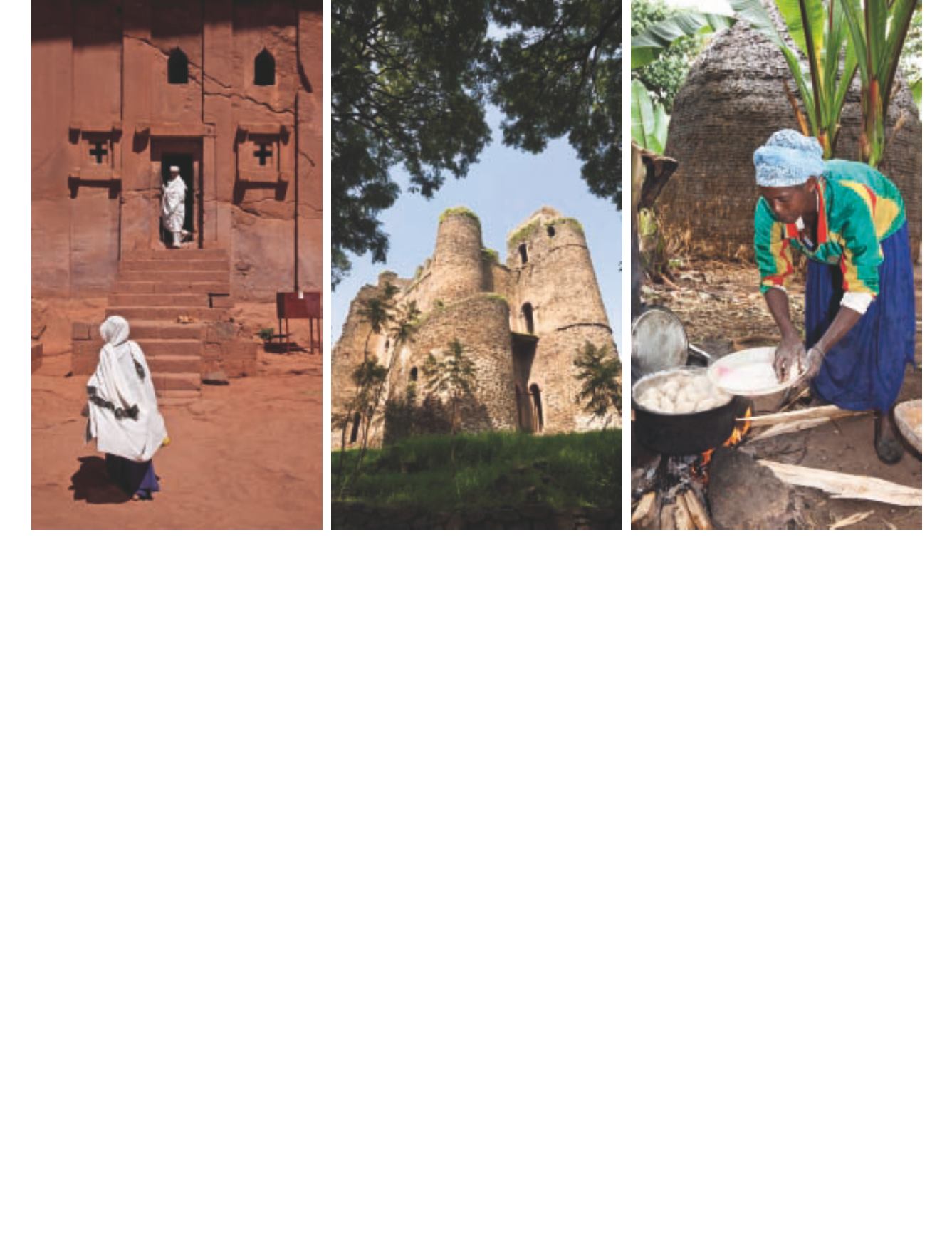
Dallol Depression and Ertale Active Volcano
One of the remotest spots and the lowest elevation on
Earth has a unique land formation within the Great Rift
Valley system. Even today, this part of the world is still
unstable. It is extremely hot, with an average temperature
of 50 degrees celsius. It is an inhospitable place with an
extraordinarily colorful landscape.
Gondar
The ancient capital of Ethiopia (1632-1855) is the site of
many ruined castles, including the grand Fasil Ghebbi –
home to the country's emperors during the 17th and 18th
centuries.
Lalibela
Famous for its 12th-century, rock-hewn churches, Lalibela
is a must see. Bete Medhane Alem is believed to be the
largest monolithic church in the world.
Semien Mountains
The mountainous highlands constitute one of the major
ranges in Africa. The region includes many summits above
4,000 meters and culminates at its highest point in
Ethiopia, Ras Dejen, at 4,630 meters, the fourth highest
mountain in Africa. Various species of indigenous mammals
are found here, such as Walia ibex, Semien fox and Gelada
baboon. In addition, there are many indigenous bird and
plant species.
The Bale Mountains
A high altitude plateau broken up by numerous spectacular
volcanic plugs and peaks, beautiful alpine lakes and
rushing mountain streams that descend into deep rocky
gorges on their way to the lowlands below. As you climb
up the mountains you will experience changes in
vegetation, from juniper forests to heather moorlands and
alpine meadows, which at various times of year are covered
in an abundance of colorful wildflowers. Bale Mountains
National Park is the largest Afro-Alpine habitat in the whole
of the continent. It provides opportunities for unsurpassed
mountain walking, horse trekking and scenic driving, as
well as the chance to view many of Ethiopia's endemic
mammals, in particular the mountain nyala and Semien fox,
and birds such as the thick-billed raven, wattled ibis, blue-
winged goose and Rouget's rail.
Cultural Holidays
Ethiopia is a veritable mosaic of peoples; there are over 83
ethnic groups, each with its own language, several of
which have not yet been classified by linguists. Although
the original physical differences between the major ethnic
groups have been blurred by centuries, if not millennia, of
intermarriage, there remain many who are distinct and
unique. There is a bounty of fascinating costumes, colorful
ceremonies and celebrations, arts, crafts, music and dance
that distinguishes Ethiopia as a diminutive Africa.
Visiting Ethnic Groups
To the west of Konso land (in the south of Ethiopia), toward
the town of Jinka at the foot of the Mago National Park,
the trail enters the bushy savanna of the Omo Valley. In this
desolate region a number of different peoples lead
nomadic or semi-nomadic lives. From the north of Turkana
up to the Sudanese frontier, the Bume, the Karo, the
Benna, the Hammer, the Geleb, the Mursi and other ethnic
groups co-exist in a hostile territory isolated from and
forgotten by the rest of Ethiopia and the world at large.
Flower/botany tours
Ethiopia is a country of great geographical diversity with
high and rugged mountains, flat-topped plateaus, deep
gorges, incised river valleys and rolling plains. The country
is endowed with great ecological and biological diversity.
The altitudinal variation provides a wide range of climatic
conditions. This has created a diverse environment, home
to a large number of flora and fauna. The flora of Ethiopia
is very diverse and has a rich endemic element. It is
estimated that between 6,500 and 7,000 species of plants
grow in Ethiopia, of which about 12% are endemic, which
are particularly prolific in the arid lowlands.
Fishing
You can fish the rivers and streams of the Bale Mountains
and the many lakes in the Rift Valley. Local fishermen offer
trips in their own boats. Dugout canoes or traditional
papyrus boats can also be hired.
Hiking
Great areas to explore include the Semien Mountains
National Park with its spectacular views and large variety of
wildlife, the moorlands of the Bale Plateau, and the
countryside around Lalibela.
Pony trekking
Riding through the Semien Mountains allows visitors to
reach remote areas not accessible by car. Horses and mules
still play an important part in transportation, and horse
riding can be practised in most parts of Ethiopia.
Safaris
Ethiopia has 14 major wildlife reserves. Safaris are usually in
4-wheel drive vehicles, but walking safaris (with a guide) or
traveling by mule are also possible.
Shopping
The Mercato, one of the largest markets in Africa, is
situated in the western sector of Addis Ababa.
Swimming
Lake Langano has a resort, offering windsurfing and water-
skiing. Natural springs in the Awash National Park and at
Sodere Filwoha create pools highly valued for their
therapeutic purposes, though they are not fully utilised.
Water Sports
Sailing and organised boat trips are available on Lake Tana,
Ethiopia's largest lake, which contains 37 islands complete
with numerous monasteries which can be visited. White
water rafting is possible on parts of the Omo River and the
Blue Nile.
105
Lalibela, Fasil Ghebbi, Dorze Lady


